Sri Lanka’s Savior Can be the Ceylon Electricity Board
By Eng Parakrama Jaysinghe
A fresh look at the Long Term Generation Plans
I listened with growing interest to the Pod Cast of The SLEN. Editor’s interview with Eng. Laksitha Weerasinghe in the August SLEN. In spite of the unfortunate misinformation on the true cost of coal power as the cheapest source of power right at the beginning, it was most interesting and revealing to listen to, and I congratulate the Editor on the manner in which this interview was conducted. The subject was on the planning process for the long term generation of electricity. Who is better equipped to talk on this subject that the DGM Generation Planning of the CEB, Eng, Laksitha Weerasinghe?
As the discussion proceeded, I believe all of us in Sri Lanka could be expected to cheer from the roof tops, on listening to the most laudable comments on the CEB’s desire to make Sri Lanka’s electricity generation form renewable resources and the recognition of the value of renewable energy , for the country in doing so.
Quote
“ That means we can certainly rely on renewable forms of energy to meet our future electrical requirements. As a result we are fully in agreement with the general view in the society that the country should gradually relieve itself from the dependency on imported fossil fuels and go for indigenous renewable forms of energy “
Unquote
I believe the operating word here is “ Gradually” . May I point out that even the current policy is to reach only 70% contribution from the current 35% contribution by renewable energy sources over a period of 9 years and therefore the government policy is quite in line with this strategy?.
Unfortunately, his latter comments cast very much doubts on the veracity of these sentiments, due to the many prejudices verging on lack of appreciation of the tremendous advancements and changes in the field and may I say less than open minded judgements on the changes necessary to achieve this goal, which tended to convey the impression that this is not a viable target. Therefore, one was left with the impression that Sri Lanka would continue to wallow in the fossil fuels trap for the foreseeable future, as the step by step and slow progress advocated, did not have an end date. Are we so inept to take up a challenge and declare war on a battle which now even the CEB is admitting is for the good of the country. I am reminded of the dozens of experts coming out of the wood works spreading doom and gloom on the proposals to take Sri Lanka towards natural and ecological agricultural practices. While this change can and will be made by many thousands of people who have already embarked on this path, fortunately not being hampered by the state authorities, the electricity sector will have to depend on the good will and vision of the CEB, with the monopoly over the sector. But we would like to pay very much attention to the encouraging words of Eng. Weerasinghe and this is an appeal to him and his colleagues at CEB to be much more proactive and think out of the box, if you would pardon the much abused cliché.
Eng Weerasinghe in his position as the DGM Transmission Planning, with the access to all the relevant data, is best placed to head this revolution. We are left in no doubt of his vision by his remarks on the possible impacts by this change over on the economy, and the wider benefits that would accrue to the country at large. We beg to point out such impacts, all of which are positive are far more than what was mentioned as cursory remarks during the interview. Naturally an interview lasting only a few minutes is not the occasion to explore these at length and the purpose of this note is to encourage him to explore these in much deeper depth.
Encouraged by the positive stance shown, we would like to request the management and all engineers at the CEB to take several steps back, and review the following. Although these suggestions come from a None Electrical Engineer and someone who is not supposed to have any knowledge on the working of the Power Sector, I hope that in the crucible of basic common realities, which cannot be ignored, they would deserve some consideration. I would however confess to be in regular touch with the events taking place in the wider world, on the energy sector and both as an engineer and a citizen, and always would like to dream of how such changes could benefit all of Sri Lanka in many aspects, not limited to the mere supply of electricity.
Of course there are some elements in the CEB who believe that seeking and accessing such knowledge is heretical, when all the knowledge, adequate and good for us poor consumers are disseminated by them.
But we have all the confidence that those in CEB with the correct attitude to be of service for the eventual good for the country, would take time to look at these suggestions without bias or prejudice, and fine tune the proposals using their access to the relevant data and superior knowledge and experience. After all it is the same steel that would end up in a plow shear or a sword. It is our firm belief that the opportunities available already with us can be used to make a major step towards the ultimate goal of 70% RE contribution by 2030, and buy the time to tackle the more difficult task in the years ahead as outlined below.
For young Eng. Weerasighe the time span of a mere 9 years may seem far too short, but for those of us past the prime, it is a bridge too far, unless we see the correct changes in the coming few years. And as it very likely to turnout later this year at the COP 26, the pressures to make the change could come from quarters, quite outside any control we would have. It is therefore another reason to be prudent and be ready before decisions are forced on us. This is not the place to discuss this aspect at length. But the threat is quite real.
Some notions in need of Correction
Let me start by putting to rest the misinformation that coal power is the cheapest option. The documents submitted by the CEB itself to the PUCSL in the past, provided the information to destroy this myth. The double whammy faced by us by both highly depreciated rupee and the spike in the price of coal would make this even worse. Please see below the analysis presented recently by the Chairman SLSEA, who undoubtedly have access to the necessary reliable information. These estimates are without any provision for the cost of externalities.
 Source: Eng. Ranjith Sepala Chairman SLSEA
Source: Eng. Ranjith Sepala Chairman SLSEA
Fortunately we can heave a sigh of relief as, His Excellency the President has very firmly stated that no more coal power plants will be installed. So let us not waste any more time flogging this dead horse.
But let us look at the bigger picture. The CEB as the state owned monopoly utility has no option but to comply with national policy, which is to achieve the goal of 70% contribution by renewable energy resources by 2030. There is no more room to question the validity of this policy target as already informed to the CEB as well as to the regulator PUCSL and also declared as a Cabinet Decision on the 13th September 2021. One would say that any attempt to ignore same or seek other goals would tantamount to sabotage of national policy, which in some countries would result in severe consequences. While some experts may continue to wax eloquent, why this goal cannot be achieved for whatever reason, CEB is duty bound to come up with the plans and programs to achieve the target, both in time and scope.
Let us take a lesson from neighboring India. When Prime Minister Mody declared his target of adding 100,000 MW of solar power, we did not hear of any utilities coming up with excuses why it cannot be done. Instead India now has a target to achieve 170,000 MW target by 2030. Shouldn’t we feel ashamed even to cast doubts on a much smaller target of about 16,000 MWh addition making use of a number of resources that mother nature has endowed Sri Lanka with in abundance. We invite our fellow engineers in the CEB to accept this challenge and establish their reputation, as the most competent to be entrusted with this task. Please ignore the laggards inside and outside the CEB, as they no doubt cannot see beyond their noses.
I kindly request Eng. Weersasinghe and his colleagues to give a fair consideration to the following comments, in respect of the barriers listed as the reason for his belief, that this change would take a much longer time. I appreciate once more that at no point did he say that it cannot be achieved or it is not technically feasible, but did worry about the time needed and perceived high costs and the access to the funds necessary.
What is the Gap in generation capacity to be filled?
To start with, accepting the projected expansion of demand up to 30,800 GWH by 2030, which may not come to pass given the problems created by the Covid which unfortunately may remain a problem for some time, my main concern is that only wind and solar, both at present lumped as VRE resources are being considered as the only contenders to fill the gap. However, if Sri Lanka accepts the inevitability of the need for electrification of transport even to some extent by 2030, it is better to accept this target. So the gap to be filled is about 16,000 GWh annually by 2030. But why are other firm sources of energy, primarily Bio Energy not being considered. If not for the most unfair blockage created by the CEB we would have added several hundred MW of distributed firm Dendro plants over the last five years. Two reputed international agencies ADB and JICA have estimated the viable and practical contribution as 2500 MW. This at a minimum of 80% plant factor could add 17, 520 GWH annually by 2030. I suggest that at least 1000 MW of Dendro power be targeted with a contribution of 7000 GWh and that would halve the contribution needed from Wind and Solar. Also there seems to be an assumption that the contribution from Hydro Power, both major and mini hydro would remain static.
The latest contribution by the different sources of energy to the generation mix as per the latest CEB statistics (2019) are given below.
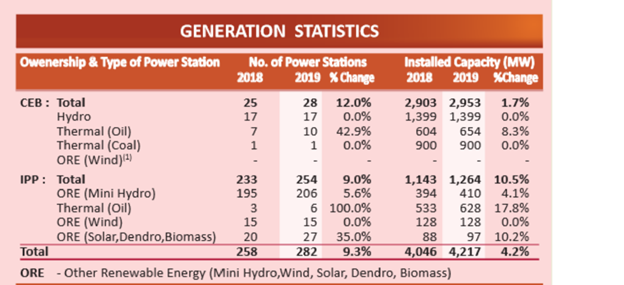
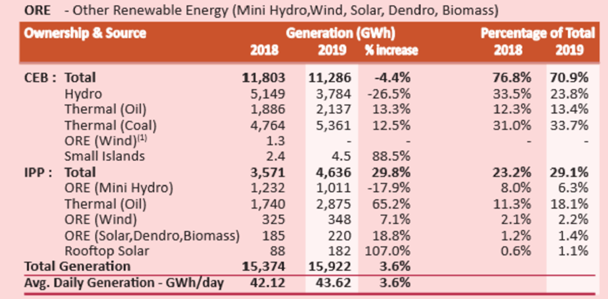
Accordingly, the renewable resources have contributed 5370 GWh or 33.7 % to the gross generation. While this was dominated by Hydro power including mini hydro projects, much more solar and wind contribution has been made in the later years, now at 458 MW of Solar and 248 MW of Wind including the 100 MW by CEB in Mannar. Even though no further addition of hydro power is assumed, which is a most retrogressive stance, at least this amount of renewable contribution must be accounted for in predicting the additions required by year 2030 to meet the 70% target.
It is good to take another look at the numbers.
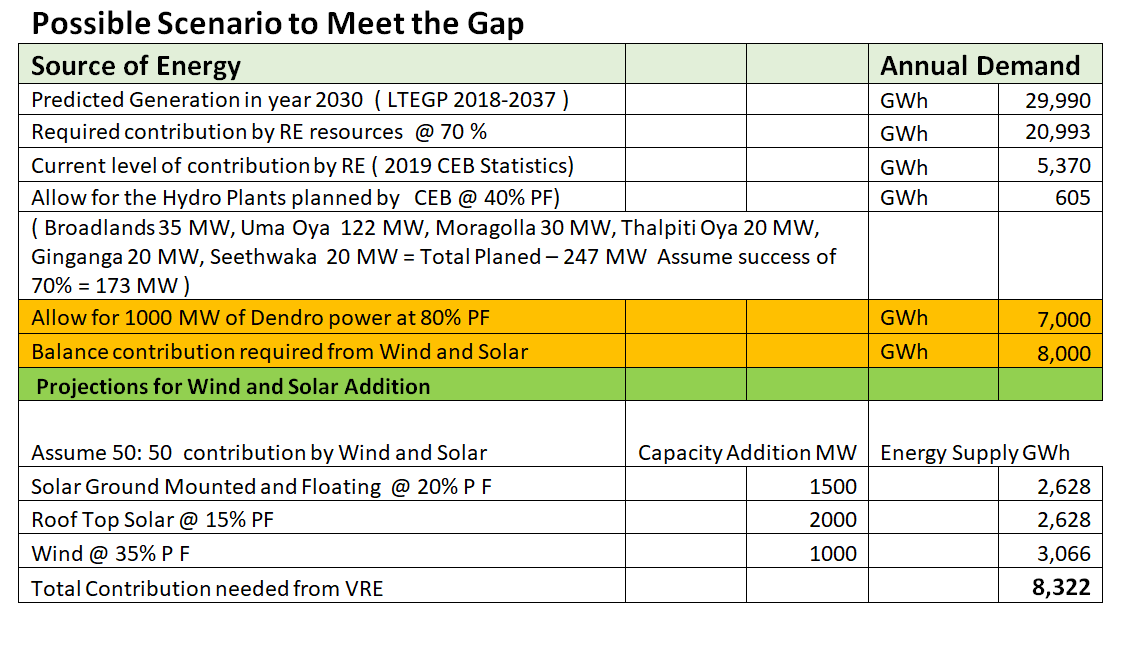
As the above table indicates, the requirement of new additions of centralized Solar and Wind power plants are halved and are more in line with the current planning with

Total Solar Park Projects in pipeline - 1656 MW (against 2000 MW required)
Potential Addition to Solar Roof Top - 200 MW x 9 = 1800 MW + 458 MW already commissioned
(Against the 2000 MW required)
Wind power plants in pipe line
Pooneryn and Mannar - 599 MW ( This does not include the 100 MW recently commissioned in Mannar) ( LTEGP 2018-2037)
These are all private sector funded projects which indicates the appetite for the investors to enter this sector, judging by the large number of offers received for the tenders floated. The experience gained by the CEB will ensure that any future renders are better structured and therefore could reach early commissioning.
Therefore Sri Lanka is already well on the way, with the potential being much higher for both Solar and Wind , all of which could be funded by private sector, preferably by Sri Lankan enterprises , but with foreign investments where necessary, which should be negotiated for conditions favorable for Sri Lanka.
The only sector which has not received adequate attention is the Bio Energy Sector which does not pose any technical challenges to the CEB. But it is hoped that the authorities will at least now recognize the great benefits of developing this source of firm energy.
New thinking is the need of the hour
As such, the final goal is not as daunting as appears at first sight, and we can and should develop proactive ways of meeting the challenge. This naturally requires new ways of looking at the need and adopting many new approaches already being practiced in other countries.
The very significant success of the roof top solar project now reaching near 400 MW is a matter of pride for Sri Lanka Energy Sector and for the CEB and LECO , and those who entered this field initially did so under clearly unattractive financial parameters, but driven by a vision for none dependent Energy sector for Sri Lanka. The circumstances have improved greatly which has taken the number of installations to over 32,000.
This should be treated as the low hanging fruit with none of the issues related to land clearance etc not being present, and the investment being highly distributed among the consumers themselves. While the CEB must be congratulated for formulating the highly visionary Surya Bala Sangraamaya , their continued proactive support is required to ensure the early and maximum benefit to the country.
If the long outstanding approval of the hybrid inverters is released the advantages with limited Behind the Meter storage will kick-in in double quick time, multiplying benefits to the grid.
The perceived problems of Cost and Time for Implementation.
The main problem that Eng. Weerasinghe focuses is on what CEB perceives as the need for a 400 kV backbone transmission line to absorb all the new renewable energy development on one hand, and the large capacity battery system to overcome the variable nature of the Solar and Wind power. Estimates of $ 1.7 Billion and $2.0 Billion has been cited.
But why are we talking about only large centralized power plants, which has been the mindset, when only large scale fossil fuel based power plants were on the cards? Even in Sri Lanka we already have several 10 MW scale solar and wind power plants operating for some years providing yeoman service. Isn’t it better to focus on overcoming any issues related to the intermittency rather than planning 100 MW or larger plants? After all unlike fossil fuel plants, both solar and wind plants consists of large number of smaller units, which are feasible to operate even in that scale. The often cited economies of scale in promoting the large scale plants must be examined in a holistic manner, by considering the eventual cost to the consumer, which includes the cost of long transmission lines and the ensuing transmission loss.
It is encouraging to note that Eng. Weerasinghe too has recognized the value of this option by his statement
Quote
“There are very successful local companies which have invested in wind power. We must make this journey in such a way that local players, or new small players or those who are already experienced to come and do development of RE and thus get benefitted from the opportunity. To do so we must go gradually big with a mixed model. But if we simply rush to a high target, you will soon see only big international companies coming and doing the development”
Unquote
We agree whole heartedly. It is not too late the exercise this option by making the Siyambaladuwa 100 MW plant to be at least a 4 x25 MW project with National Competitive Bidding and adopting the same model for other forthcoming projects too. I have explined the desirability of this option by my article “Are we to buy our solar energy with dollars?
https://island.lk/are-we-to-buy-our-solar-energy-with-dollars/
The Issue of Initial Capital Costs of RE Projects
There has been many loose statements made that the initial capital costs of RE projects are very high and front loaded, whereas the cost of operating the conventional plants are spread over its life cycle. It is unfortunate that this statement without any basis of truth, has also been repeated during this interview. The table below illustrates the true situation. Whereas coal power plants fail the test right at the beginning, the LNG power plants presently in vogue, also does not fare any better when the inevitable continuing cost of fuel to be paid in Dollars is considered. In the worst case the difference in initial capital cost will be offset in a mere 2 to 3 years.
If the cost of batteries required to graduate the Wind and Solar plants to be dispatchable this period would increase perhaps by a further 12 months. This is seen in the calculation for the Bio Mass projects which are a firm source of power. I invite anyone to check the calculations and make any corrections necessary. It is most unlikely that there would be a significant change in the basic reality, whatever corrections are made.
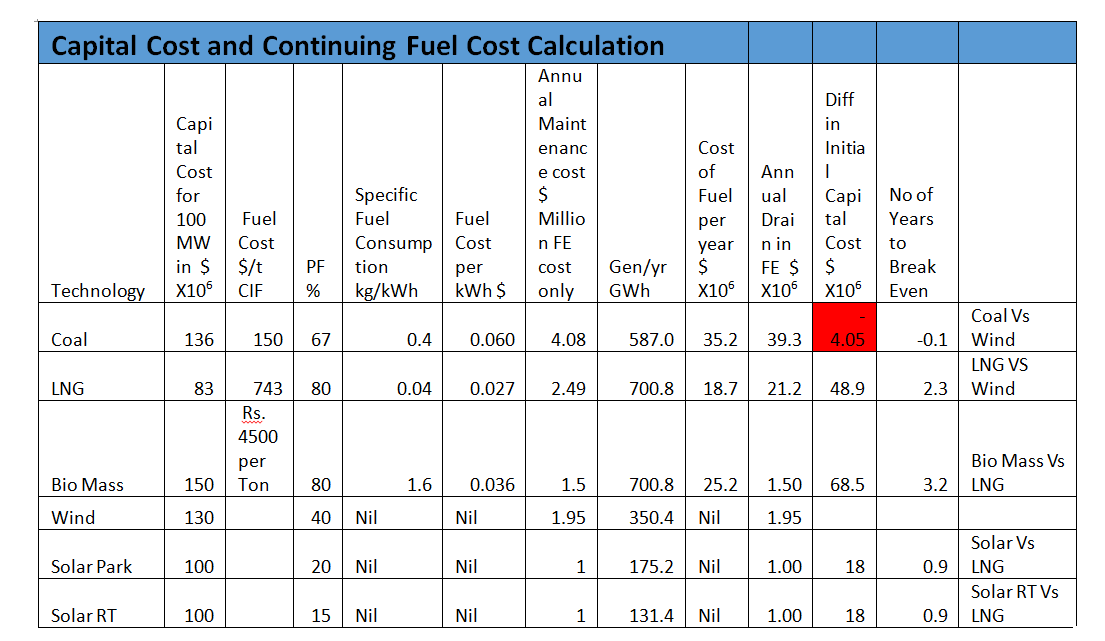 Sources : CEB Statistics, recent public documents, Note : The maintenance cost percentages used are to represent the forex costs only.
Sources : CEB Statistics, recent public documents, Note : The maintenance cost percentages used are to represent the forex costs only.
The Need for Transmission Expansion and Storage
No doubt with the increase in the generation capacity, irrespective of the contribution by RE sources, there would be the need for improvements and expansion of the transmission system. But the extent and the type of modifications required will have to take in to account the Sri Lanka’s firm policy to reach 70% RE contribution by 2030, once more confirmed by the Cabinet on the 14th September 2021. Therefore it is unwise to plan any major transmission system changes without first reaching a decision on the mode and action plan and timing of the new additions to the renewable energy portfolio. Therefore the judgement that Sri Lanka would need a 400 kV backbone transmission line at a cost of $ 1.7 Billion appears to be premature. As suggested earlier, the decision to install large centralized power plants, which we believe is the basis for this contention, needs much deeper analysis. The world is moving towards distributed generation closer to the load centers, where ever possible.
Fortunately the General Manager of CEB recently at a public seminar, declared that there are no changes needed in the transmission system till we add further 1000 MW of VRE, which would buy us time for such analysis.
There is no argument that the two main contenders targeted to bridge the gap to reach 70% RE, are variable and therefore some form of storage system would be needed early. Although the bounty of large hydro reservoirs already in place, if strategically deployed would be a valuable asset to be harnessed, the need for batteries of appropriate size would also be needed sooner than later.
Here too, we regret to note hasty prognostications being made on both the capacity and cost of such storage. Perhaps Sri Lanka is the only country where large scale storage batteries are still considered a yet to be proven emerging technology. With the staggering new advances being made in battery technologies and downward trends of cost, the world has embraced battery storage as a viable option to support the expansion of VRE and have made significant commitments for addition of storage capacities. The iconic 100 MW battery in Hornsdale Australia several years ago, has now entered historical records and has paid for itself several time over and spurred a storage revolution in Australia.
Contrary to the statement that the world deployment of batteries is only 2000 MW the reality is quite different as noted below.

Longer-term, there are 6,160MW of utility-scale stand-alone storage and 9,881MW of utility-scale solar-plus-storage listed.
US energy storage industry’s target is to add 35 GW of new capacity by 2025.
https://www.bing.com/search?q=utility+scale+energy+storage+2020&qs=n&form=QBRE&sp=-1&pq=utility+scale+energy+storage+2020&sc=1-33&sk=&cvid=C3AB894ACC584C609D41E1C70696B979
India too has very strongly entered the race with plans to have 27 GW /108 GWh of battery storage installed by 2030.
On the cost front too, the positive trend continues with a downward trend in costs fast reaching the threshold of $ 100/kWh considered the tipping point for even smaller scaled storage such as behind the meter batteries.
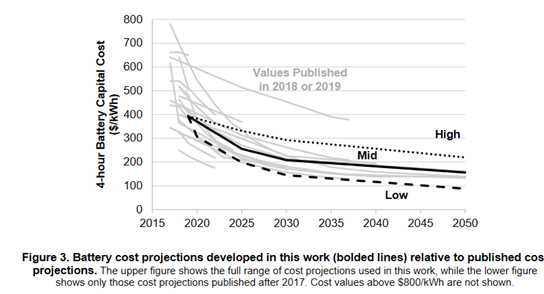
https://www.nrel.gov/docs/fy20osti/75385.pdf (Viewed on 7th Sept 2021)
The Chairman SLSEA recently announced the projected battery storage cost as only Rs 3.50 per kWh by 2025 down from the current Rs 8.50 per kWh , based on data obtained from battery manufacturers. We are fortunate that Sri Lanka now has three successful entrepreneurs, entering the energy storage development, with Li Ion and flow batteries which are ideal for electricity storage at the scale needed by us.
So any predictions on cost of storage even a few years to the future is risky.
Vison for the Future
Although I could go on further, addressing some more issues, I think I have provided enough reasons why we need to take very hard look at how we manage the future of our electricity sector. We need to charter a course, most beneficial to Sri Lanka in all aspects of energy security, least economic cost, none dependence on imported polluting fuels and more than anything the pride of our engineers’ capability of facing any difficulty and come up champions. The immediate economic and financial benefits of adoption of indigenous renewable sources is vital and much more important to us than the undoubted environmental and other benefits which will naturally accrue. This potential is what should drive and provide the impetus for this change and hence the urgency in doing so. Sri Lanka has for several decades now, has accepted the role to be played by the private sector in the Energy Sector. This would need to be expanded further, with due care and proper regulation in the interests of the country and the consumer. However, to date electricity still remains as a minor player in the energy field with only 11 % contribution. But if the proposals for electrification of transport is pursued that contribution can exceed 50% and CEB can and should be the champion for this change. Then they can truly command the respect and gratitude of the country and hence the title of this article. “Sri Lanka’s Savior Can be the Ceylon Electricity Board”
This lays the burden on the CEB to be the shining light to provide the leadership and guidance with a can- do attitude from the start. Let us not throw away the baby with the bath water and lose this opportunity. We look forward to the CEB which has all the knowledge and experience to do so, if only they can rid themselves from baggage from the past, and be open to accept and adapt what is already happening all over the world for the optimum value for Sri Lanka.
 Eng. Parakrama Jayasinghe is a Chartered Mechanical Engineer with a BSc Eng (honours) degree from the University of Peradeniya. He is fellow of the Institution of Engineers Sri Lanka and a Member of the Institution of Mechanical Engineers London.
Eng. Parakrama Jayasinghe is a Chartered Mechanical Engineer with a BSc Eng (honours) degree from the University of Peradeniya. He is fellow of the Institution of Engineers Sri Lanka and a Member of the Institution of Mechanical Engineers London.




